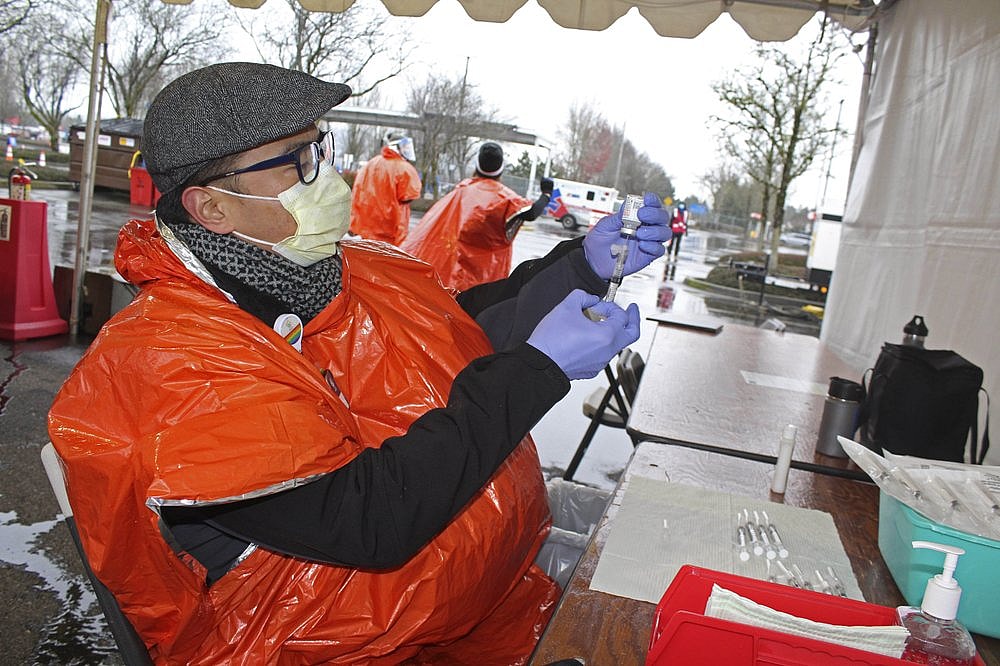The role that race should play in deciding who gets priority for the COVID-19 vaccine was put to the test Thursday in Oregon, but people of color won’t be the specific focus in the next phase of the state’s rollout as tensions around equity and access to the shots emerge nationwide.
An advisory committee that provides recommendations to Gov. Kate Brown and public health authorities discussed whether to prioritize racial minorities but decided on a wide range of other groups: those under 65 with chronic medical conditions, essential workers, inmates and people living in group settings.
Read More: NY nursing home virus deaths were undercounted, AG says
The 27-member panel in Oregon, a Democratic-led state that’s overwhelmingly white, said people of color likely fell into the other prioritized groups and expressed concerns about legal issues if race was the focus. Its recommendations are not binding but offer key guidance on vaccine distribution.
The committee was formed with the goal of keeping fairness at the heart of Oregon’s vaccine rollout. Its members were selected to include racial minorities and ethnic groups, from Somalian refugees to Indigenous people.

“Our system is not yet prepared to center on and reveal the truth of structural racism and how it plays out,” said Kelly Gonzales, a member of the Cherokee Nation of Oklahoma and a health disparity expert on the committee.
The panel included a statement in its plan acknowledging the impact of structural racism and saying it reviewed the needs of minority communities.
The virus has disproportionately affected people of color. Last week, the Biden administration reemphasized the importance of including “social vulnerability” in state vaccination plans — with race, ethnicity and the rural-urban divide at the forefront — and asked states to identify “pharmacy deserts” where getting shots into arms will be difficult.
Overall, 18 states included ways to measure equity in their original vaccine distribution plans last fall — and more have likely done so since the shots started arriving, said Harald Schmidt, a medical ethicist at the University of Pennsylvania who has studied vaccine fairness extensively.
Some, such as Tennessee, proposed reserving 5% of its allocation for “high-disadvantage areas,” while states like Ohio plan to use social vulnerability factors to decide where to distribute vaccine, he said. California has developed its own metrics for assessing a community’s level of need, and Oregon is doing the same.

“We’ve been telling a fairly simple story: ‘Vaccines are here.’ Now we have to tell a more complicated story,” said Nancy Berlinger, who studies bioethics at The Hastings Center, a nonpartisan and independent research institute in Garrison, New York. “We have to think about all the different overlapping areas of risk, rather than just the group we belong to and our personal network.”
Attempts to address inequities in vaccine access have already prompted backlashes in some places. Dallas authorities recently reversed a decision to prioritize the most vulnerable ZIP codes — primarily communities of color — after Texas threatened to reduce the city’s vaccine supply. That kind of pushback is likely to become more pronounced as states move deeper into the rollout and wrestle with difficult questions about need and short supply.
To avoid legal challenges, almost all states looking at race and ethnicity in their vaccine plans are turning to a tool called a “social vulnerability index” or a “disadvantage index.” Such an index includes more than a dozen data points — everything from income to education level to health outcomes to car ownership — to target disadvantaged populations without specifically citing race or ethnicity.
By doing so, the index includes many minority groups because of the impact of generations of systemic racism while also scooping up socioeconomically disadvantaged people who are not people of color and avoiding “very, very difficult and toxic questions” on race, Schmidt said.

“The point is not, ‘We want to make sure that the Obama family gets the vaccine before the Clinton family.’ We don’t care. They can both safely wait,” he said. “We do care that the person who works in a meatpacking plant in a crowded living situation does get it first. It’s not about race, it’s about race and disadvantage.”
In Oregon, health leaders are working on a social vulnerability index, including looking at U.S. census data and then layering on things like occupational status and income levels, said Rachael Banks, public health division director at the Oregon Health Authority.
That approach “gets beyond an individual perspective and to more of a community perspective” and is better than asking a person to prove “how they fit into any demographic,” she said.
Read More: Georgia medical center suspended from vaccine program after school district inoculation
That makes sense to Roberto Orellana, a social work professor at Portland State University who launched a program to train his students to do contact tracing in Hispanic communities. Data shows that Hispanic people have roughly a 300% higher risk of contracting COVID-19 than their white counterparts in Oregon.
Orellana hopes his students, who are interning at state agencies and organizations, can put their knowledge to use both in contact tracing and in advocating for vaccines in migrant and farmworker communities. Vaccinating essential workers, prisoners and those in multigenerational households will reach people of color and put them at the heart of the vaccine plan, he said.
“I don’t want to take away from any other group. It’s a hard, hard question, and every group has valid needs and valid concerns. We shouldn’t be going through this,” Orellana said. “We should have vaccines for everybody — but we’re not there.”
Have you subscribed to theGrio’s new podcast “Dear Culture”? Download our newest episodes now!
TheGrio is now on Apple TV, Amazon Fire, and Roku. Download theGrio today!

